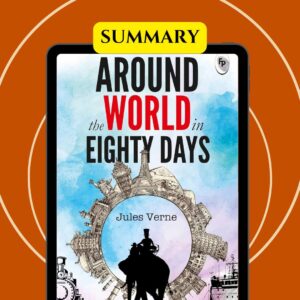Around the World in 80 Days Book Summary
Around the World in 80 Days is a timeless classic novel written by Jules Verne, a prominent French author known for his pioneering works in the science fiction genre. This novel, published in 1873, holds a significant place in literature as it showcases Verne’s innovative storytelling and imaginative narrative style, setting the stage for adventure novels to come.
Plot Overview
- Phileas Fogg, a wealthy and precise Englishman, embarks on a daring journey to circumnavigate the globe in precisely 80 days, driven by a wager made at his London club.
- Fogg is accompanied by his loyal and resourceful servant, Passepartout, who plays a crucial role in assisting his master throughout the journey.
- As they travel through various cities and countries, including London, Paris, Egypt, India, and America, Fogg and Passepartout encounter numerous challenges, such as delays, misunderstandings, and adversities that threaten to derail their quest.
- Amidst the race against time, they are pursued by Detective Fix, who mistakenly believes Fogg to be a bank robber and seeks to arrest him, becoming an additional obstacle in their path.

Table of Contents
Setting and Themes
- The novel unfolds across a diverse range of settings, from the bustling streets of Victorian London to the exotic landscapes of India and the wild frontier of the American West.
- Themes of adventure, perseverance, time management, and the pursuit of seemingly impossible goals permeate the narrative, highlighting the tenacity and determination of the characters.
- The vividly described settings and thematic elements underscore the essence of exploration, discovery, and human ambition, contributing to the rich tapestry of the story.
Character Analysis
- Phileas Fogg epitomizes precision and calmness, showcasing a remarkable sense of duty and commitment to his wager, while also revealing unexpected depths of character beneath his stoic exterior.
- Passepartout, with his quick wit and resourcefulness, serves not just as a servant but as a trusted companion to Fogg, demonstrating loyalty and courage in the face of adversity.
- Detective Fix, though initially a hindrance to Fogg’s journey, evolves into a more nuanced character, offering a contrasting perspective on duty and justice that enriches the narrative.
Writing Style and Narrative Techniques
- Jules Verne‘s writing style is marked by precise detail, evocative imagery, and a meticulous approach to storytelling that immerses readers in the journey alongside the characters.
- Through strategic pacing, subtle foreshadowing, and engaging dialogue, Verne masterfully builds tension and suspense, creating a sense of anticipation that propels the narrative forward.
- The author’s adept use of descriptive language and narrative techniques lends depth and authenticity to the adventure, captivating readers with a blend of realism and imagination.
Reception and Legacy
- Upon its publication, Around the World in 80 Days garnered widespread acclaim for its innovative premise, compelling storytelling, and vivid portrayal of travel and adventure.
- The novel’s enduring legacy in literature is evident through its continued popularity, adaptation into various media forms, and influence on subsequent works that explore themes of global exploration, time-bound challenges, and extraordinary journeys.
- Verne’s timeless classic continues to captivate audiences worldwide, exemplifying the enduring appeal of adventure fiction and the enduring power of storytelling to transcend time and culture.
Critical Analysis
In this section, we delve deeper into a critical analysis of Jules Verne’s masterpiece, Around the World in 80 Days, exploring its themes, characters, and plot intricacies.
Themes Explored
- Adventure: Verne encapsulates the essence of adventure through Phileas Fogg’s quest, portraying a thrilling journey where the unexpected becomes commonplace.
- Time Management: The novel’s central element of time pressures Fogg to plan meticulously, emphasizing the significance of time in achieving extraordinary feats.
- Global Exploration: Through Fogg’s travel itinerary, readers are transported to diverse landscapes, highlighting the allure of discovering new cultures and places.
Characters Examined
- Phileas Fogg: An enigmatic figure, Fogg’s stoicism and unwavering determination to win the wager showcase a complex character driven by precision and intellect.
- Passepartout: Fogg’s loyal valet adds a touch of humor and warmth to the narrative, serving as a contrast to Fogg’s calculated persona.
- Detective Fix: The persistent antagonist, Fix’s pursuit of Fogg adds suspense and intrigue, questioning the boundaries between law and morality.
Cultural and Historical Context
- Verne’s narrative reflects the Victorian era’s fascination with exploration and technological advancements, mirroring a time when global travel sparked imaginations.
- The novel’s portrayal of different societies and customs provides insight into the colonial mindset prevalent during the 19th century, offering a nuanced view of cultural interactions.
Comparison to Other Works
Standout Features
- Verne’s novel distinguishes itself through its focus on precise time constraints, setting it apart from conventional travel adventure stories that may lack this sense of urgency.
- Unlike other works in the adventure genre, Around the World in 80 Days intricately weaves elements of suspense and intellectual challenges, elevating it as a classic with enduring appeal.
Similar Themes in Literature
- When compared to other travel literature like Mark Twain’s The Adventures of Huckleberry Finn, Verne’s novel juxtaposes a race against time with a journey of self-discovery, presenting contrasting thematic elements.
Adaptations and Film Versions
Evolution of Adaptations
- From silent films to modern-day reimaginings, Verne’s timeless tale has undergone various adaptations, each adding a unique spin to the original narrative.
- Different adaptations capture the essence of Fogg’s global journey, showcasing the artistic interpretation of how a trip around the world can be visualized on screen.
Storytelling and Visual Representation
- While the original novel focuses on detailed descriptions and internal dialogues, film adaptations rely on visual cues and cinematic techniques to convey the fast-paced nature of Fogg’s expedition.
- The evolution of technology has allowed filmmakers to create stunning visuals that bring to life the exotic locales Fogg visits, enhancing the audience’s immersive experience.
Popularity and Influence
Continued Relevance
- Despite being written in the 19th century, Around the World in 80 Days remains a timeless classic, resonating with readers due to its universal themes of adventure and determination.
- Verne’s novel has inspired generations of travelers and adventurers, sparking a sense of wanderlust and curiosity about the world beyond one’s comfort zone.
Enduring Impact
- The book’s enduring popularity can be attributed to its captivating storytelling, memorable characters, and the enduring appeal of a high-stakes wager set against a backdrop of global exploration.
- By intertwining time pressure with the allure of distant lands, Verne crafted a narrative that continues to captivate audiences worldwide, solidifying its place in literary history.
Frequently Asked Questions (FAQs) about Around the World in 80 Days Book Summary
What is the main plot of Around the World in 80 Days?
The main plot revolves around Phileas Fogg, a wealthy but precise Englishman, who embarks on a journey to circumnavigate the globe in just 80 days to win a wager he made with fellow members of the Reform Club in London.
Who are the main characters in the book?
Key characters include Phileas Fogg, the protagonist; Passepartout, his loyal and resourceful French valet; and Detective Fix, who mistakenly believes Fogg to be a bank robber and pursues him throughout his journey.
How does the book explore the theme of adventure?
The novel vividly captures Fogg’s daring and unconventional travel itinerary, filled with unexpected challenges, exotic locales, and thrilling encounters that highlight the spirit of adventure and exploration.
What is the writing style of Jules Verne in Around the World in 80 Days?
Jules Verne’s writing style is characterized by his meticulous attention to detail, descriptive language that brings each setting to life, and a fast-paced narrative that keeps readers engaged as Fogg races against time.
Why is Around the World in 80 Days considered a literary classic?
The novel is revered for its innovative storytelling, timeless themes of adventure and determination, and enduring appeal that has captivated readers worldwide for generations.
Conclusion
In conclusion, Around the World in 80 Days by Jules Verne continues to stand the test of time as a masterpiece of adventure literature that has left an indelible mark on the literary world. With its iconic characters, thrilling plot, and exploration of themes such as time, travel, and perseverance, this classic novel remains a beloved favorite among readers and continues to inspire generations with its timeless tale of a remarkable journey around the globe.





